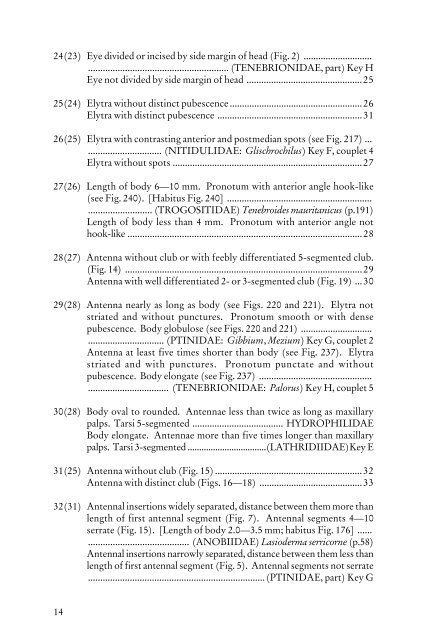Beetles Identification Guide
Beetles Identification Guide
Beetles Identification Guide
Create successful ePaper yourself
Turn your PDF publications into a flip-book with our unique Google optimized e-Paper software.
24(23) Eye divided or incised by side margin of head (Fig. 2) ............................<br />
......................................................... (TENEBRIONIDAE, part) Key H<br />
Eye not divided by side margin of head ...............................................25<br />
25(24) Elytra without distinct pubescence ......................................................26<br />
Elytra with distinct pubescence ...........................................................31<br />
26(25) Elytra with contrasting anterior and postmedian spots (see Fig. 217) ...<br />
.............................. (NITIDULIDAE: Glischrochilus) Key F, couplet 4<br />
Elytra without spots .............................................................................27<br />
27(26) Length of body 6—10 mm. Pronotum with anterior angle hook-like<br />
(see Fig. 240). [Habitus Fig. 240] ...........................................................<br />
.......................... (TROGOSITIDAE) Tenebroides mauritanicus (p.191)<br />
Length of body less than 4 mm. Pronotum with anterior angle not<br />
hook-like ...............................................................................................28<br />
28(27) Antenna without club or with feebly differentiated 5-segmented club.<br />
(Fig. 14) ................................................................................................29<br />
Antenna with well differentiated 2- or 3-segmented club (Fig. 19) ...30<br />
29(28) Antenna nearly as long as body (see Figs. 220 and 221). Elytra not<br />
striated and without punctures. Pronotum smooth or with dense<br />
pubescence. Body globulose (see Figs. 220 and 221) .............................<br />
............................... (PTINIDAE: Gibbium, Mezium) Key G, couplet 2<br />
Antenna at least five times shorter than body (see Fig. 237). Elytra<br />
striated and with punctures. Pronotum punctate and without<br />
pubescence. Body elongate (see Fig. 237) ..............................................<br />
................................. (TENEBRIONIDAE: Palorus) Key H, couplet 5<br />
30(28) Body oval to rounded. Antennae less than twice as long as maxillary<br />
palps. Tarsi 5-segmented ..................................... HYDROPHILIDAE<br />
Body elongate. Antennae more than five times longer than maxillary<br />
palps. Tarsi 3-segmented ..................................(LATHRIDIIDAE)Key E<br />
31(25) Antenna without club (Fig. 15) ............................................................32<br />
Antenna with distinct club (Figs. 16—18) ..........................................33<br />
32(31) Antennal insertions widely separated, distance between them more than<br />
length of first antennal segment (Fig. 7). Antennal segments 4—10<br />
serrate (Fig. 15). [Length of body 2.0—3.5 mm; habitus Fig. 176] ......<br />
......................................... (ANOBIIDAE) Lasioderma serricorne (p.58)<br />
Antennal insertions narrowly separated, distance between them less than<br />
length of first antennal segment (Fig. 5). Antennal segments not serrate<br />
........................................................................(PTINIDAE, part) Key G<br />
14
















